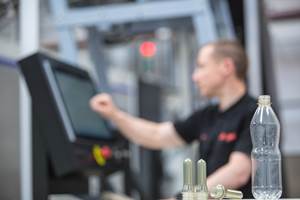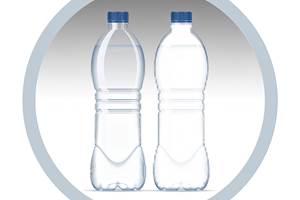What's New at the Show in BLOW MOLDING
There will be a strong emphasis on energy savings in blow molding machinery at K 2007.
There will be a strong emphasis on energy savings in blow molding machinery at K 2007. This will be the main rationale behind introduction of all-electric extrusion and injection-blow machines, as well as a new electric-hydraulic hybrid shuttle that uses hydraulics only on the clamp. Other innovations at the show will include a compression molding system for PET preforms and a new way to produce lightweight PET water bottles.
All-electrics & hybrids
Techne’s new Advance all-electric extrusion blow series has clamp capacities up to 20 tons, reportedly allowing the highest cavitation of any all-electric shuttle today. Techne claims energy savings of 35% and cycle-time reduction of 10% to 25% vs. hydraulics. The Advance series incorporates Techne’s Veltech fast-cooling technology to further cut cycle time.
The servo-driven Advance 510 and 700 models have one to four molds and modular construction. With twin shuttles, maintenance can be done on one shuttle while the other is in operation. Machine control utilizes a CANbus network, which simplifies wiring and diagnostics when troubleshooting the electrical system. Lower maintenance is another claimed benefit. Techne also developed control software that automatically uses the minimum clamp force necessary, saving energy and extending mold life. At the show, a 20-cavity Advance 510 will mold 250-cc oval shampoo bottles.
Energy savings are also claimed for a new hybrid continuous-extrusion shuttle machine from Uniloy Milacron. The UMS 16H.S reportedly uses 22% less energy than standard hydraulic shuttles. All movements except the clamp were switched from hydraulic to electric drives. A new scrap-removal system developed with German moldmaker Friedrich H. Weischede is said to guarantee 100% flash separation. At the show, a single-cavity hybrid will mold 10L containers weighing 350 g at 180 parts/hr with the aid of two post-cooling stations. A combined leak tester and weigh scale (APIS model WV-01) will be linked to the B&R machine controller. If the product weight varies, the die will be adjusted automatically.
One of the first all-electric injection-blow machines also will be launched by Uniloy Milacron. The UMIB 100 is a 100-ton unit that reportedly uses 40% to 60% less energy than the same size hydraulic press. Target applications include medical and pharmaceutical bottles from 5 cc to 1L. Features include a nickel-coated mold area and laminar air flow above the mold to prevent dust and contamination. The mold area is also kept under positive pressure to avoid contamination. At the show, a 12-cavity unit will make 10-cc vials at 3900/hr.
New wheels and more
Graham Engineering Corp. will launch the Mini Wheel extrusion blow molder for single-serve, multilayer bottles. This high-growth market is fueled by new dairy drinks and by increased demand for coextruded barrier containers for specialty drinks such as “nutraceuticals” and “probiotics.”
The company says its 12-station Mini Wheel is an economical alternative to a shuttle, offering more consistent bottle weight and layer distribution in small bottles up to 190-mm tall.The machine’s output is about 3000 to 6000 bottles/hr. The unit can produce 200- to 500-cc dairy bottles at 6000/hr. Quick mold change is available.
Long-stroke extrusion blow machines formerly made by now-defunct SIG Blowtec have been built by Kautex Machines Inc. since 2006. The KLS long-stroke series is available with six to 14 cavities per station (on 100-mm centers). All models come with single or double stations. With output of 7000 and 8000 bottles/hr, the long-stroke series fits between conventional shuttle and wheel machines for consumer and personal-care uses.
The latest model, the KLS 6-100, is the smallest in the line. It comes with three extruders for producing coextruded bottles with a recycled middle layer. The machine also has a quick-mold-change system and integrated leak tester. At the show, a 12-cavity unit will make 65-cc bottles at 4600/hr.
PET All Manufacturing Inc., a former Canadian distributor for Magic MP of Italy, is a new supplier of blow molding machinery from Asia. Its newest continuous-extrusion shuttle is the Can 55, an eight-cavity unit that makes 50-cc to 1L bottles at about 3000/hr. It has a linear carriage and in-machine deflashing and takeout.
Davis-Standard LLC will highlight its recent entry into the intermediate bulk container (IBC) market. The company is targeting this high-growth application with its existing accumulator-head machines, such as a model with an extended-daylight 60 x 84 in. press, 75-lb accumulator, and dual 130-mm, grooved-feed extruders. Systems can be supplied with molds for 800L to 1200L IBCs.
A new model of a specialized type of injection-blow machine will be introduced by Germany’s Ossberger GmbH (represented here by FGH Systems). The Pressblower Duo 35 is for molding collapsible tubes. It has a 35-g shot size and runs two cavities.
New way to mold preforms
A potentially major development in PET preform molding comes from Sacmi of Italy, which makes high-speed, continuous systems for extrusion and compression molding of bottle caps. Its new Preform Advanced Molding (PAM) system is a 48-cavity prototype that compression molds 27,000 preforms/hr. Its carbonated soft-drink preform weighs 23 g and has a 28 PCO neck finish.
Sacmi says compression offers several advantages over injection molding of preforms. Energy savings are said to be possible in subsequent stretch-blow molding because compression molded preforms require less reheating due to different crystal orientation. Compression molded preforms can also be stretched at the bottom of the bottle due to the absence of an injection gate. Other claimed benefits are greater weight consistency and more homogeneous material distribution.
In other PET molding developments, a 500-cc PET water bottle produced on Sidel machines weighs just 9.9 g and is touted as the industry’s lightest. It weighs 25% to 40% less than the typical 13- to 16-g bottle of the same size. The sleek, flexible bottle, dubbed the NoBottle, utilizes so-called flex technology, which provides flexibility and shape memory so that bottles spring back to their original shape when deformed—all without incorporating ribs.
Typically, bottle weight can be reduced by adding ribs to brace the bottle walls. However, ribbed bottles are typically brittle and noisy when compressed, so they reduce shelf appeal.
Measuring 198 mm high x 65 mm diam., the NoBottle is easy to grip, supple, and less brittle than conventional bottles. The shape-memory effect enables the bottles to better withstand conveying, transport, and handling. The bottle was made on a Sidel Combi Universal blow/fill/cap line. Sidel will use the concept in proprietary bottle designs for its customers.
Sidel will also launch two reheat machines for larger bottles and greater outputs. The SBO 24xs Highspeed is a rotary model with a linear oven for single-serve bottles of less than 700 cc. The 24-cavity unit has a smaller footprint than the previous model and higher output (40,000 to 46,000 bottles/hr). Also new is the SBO 2XL, a linear unit for bottles up to 10L. Previously, Sidel’s rotary machines were limited to container sizes up to 5L. The new unit produces water and edible-oil bottles at 2400/hr.
Sidel claims to have developed the first automatic process regulation system for rotary blow molding machines. The Equinox system monitors and corrects bottle quality during production without time-consuming sampling and off-line testing. It measures bottle weight and corrects any deviations from the set weight by readjusting machine parameters without any downtime. This is particularly useful with lightweight bottles, which are sensitive to variances in material distribution.
SIPA of Italy will roll out its newest rotary reheat stretch-blow machine with greater output, reduced energy consumption, and lower maintenance costs. The SFR 12 EVO produces 24,000 bottles/hr vs. 21,600/hr for the previous model. It is also more flexible because the chain pitch can be changed to allow production of a wider range of neck finishes.
The oven can be programmed for hot-fillable bottles to minimize the time necessary for thermal inversion and thus improve energy efficiency. In addition, the machine has a double air-recovery system with an auxiliary tank for reduced energy consumption.
SIPA will also introduce the SFL6/4 linear reheat machine for containers up to 8L, as well as new machinery for hot-fill and oval containers with adjustable necks.
Nissei ASB Co. will launch its fourth generation of single-stage injection stretch-blow molding machines. The re-engineered four-station ASB-70DPHV4 boasts a dry-cycle time of 3.5 sec, down from 4.5 sec for the previous model. The 70-tonner comes with up to 12 cavities for containers from 30 cc to 7L. The clamp system has been redesigned with a variable-displacement hydraulic pump for 40% less power usage.
Nissei is also making a more focused effort in two-step stretch-blow molding. Nissei’s newest reheat system is the six-cavity model NB-6N for bottles from 300 cc to 3L. It has a transfer device between the heating and blowing stations to prevent stopping and starting and achieve more efficient movements. This results in increased output, reaching 7200 bottles/hr.
To complement its reheat stretch-blow machines, Nissei’s PM-70/65N is a new 16-cavity preform molding machine that produces 6000 preforms/hr for water and carbonated soft-drink bottles.
PET All Manufacturing will unveil a single-stage stretch-blow unit for small PET bottles that is said to be similar to Nissei’s model MB50. An eight-cavity unit produces 50-cc cosmetic bottles at 2000/hr.
Krones Inc. will highlight a new modular heating oven for all its Contiform two-step stretch-blow machines. The space-saving system can be adjusted to accommodate a range of container sizes.
Also new from Krones is a 0.5L non-carbonated PET bottle that reportedly offers 30% weight savings over traditional bottles. A lighter preform is achieved through material reduction in the body and neck ring. Other key features are a new bottle base design and a special cooling system in the blow molder, which eliminate the need for a base-cooling system between the blow molder and filling machine. Krones will also introduce the PETView inspection module, an in-line QC and process-monitoring system.
Related Content
Services to Help Blow Molders Convert to rPET
Sidel launches “RePETable” range of services as “one-stop” solution to efficient adoption of rPET for bottle production.
Read MoreSolve Four Common Problems in PET Stretch-Blow Molding
Here’s a quick guide to fixing four nettlesome problems in processing PET bottles.
Read MoreMold Opaque White PET Bottles – Without Pigment
Trexel and Husky are cooperating on molding recyclable opaque white preforms for PET bottles, which provide a light barrier using foam instead of pigment.
Read MoreCoca-Cola Europacific Transitions to Tethered Caps and Lighter PET Bottle
Sidel is converting all Coca-Cola PET bottling lines in Europe to meet new EU packaging regulations by July 2024.
Read MoreRead Next
People 4.0 – How to Get Buy-In from Your Staff for Industry 4.0 Systems
Implementing a production monitoring system as the foundation of a ‘smart factory’ is about integrating people with new technology as much as it is about integrating machines and computers. Here are tips from a company that has gone through the process.
Read MoreAdvanced Recycling: Beyond Pyrolysis
Consumer-product brand owners increasingly see advanced chemical recycling as a necessary complement to mechanical recycling if they are to meet ambitious goals for a circular economy in the next decade. Dozens of technology providers are developing new technologies to overcome the limitations of existing pyrolysis methods and to commercialize various alternative approaches to chemical recycling of plastics.
Read More


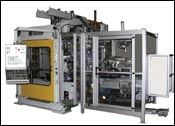
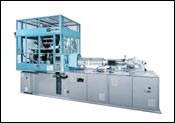

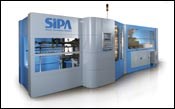










.png;maxWidth=300;quality=90)








